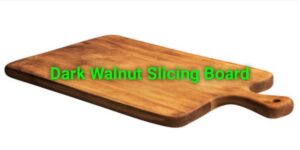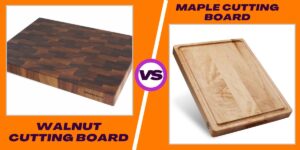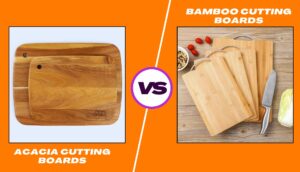If you’re looking acacia vs walnut overhaul your kitchen diversion, a quality cutting board is fundamental. Whereas plastic and bamboo sheets get the work done, genuine domestic cooks and chefs know the esteem of hardwood cutting sheets. But when it comes to hardwood, one address frequently comes up: Acacia vs Walnut Cutting Board — which is better?
After owning and frequently utilizing both acacia and walnut cutting sheets over the past few a long time, I’ve shaped clear suppositions on their masters, cons, highlights, and execution. In this post, I’ll walk you through a real-world survey based on individual involvement, highlighting what I cherish, what may be superior, and which board wins for particular uses.
Acacia Wood: Nature’s Blessing to Craftsmanship – A Individual Review:
When it comes to common hardwood, Acacia is one title that’s been turning heads. Known for its solidness, wealthy grains, and eco-friendly sourcing, Acacia wood has ended up a beat choice for everything from cutting sheets to extravagance furniture and indeed flooring. I’ve had the delight of utilizing a few acacia items over the final two years—most strikingly a eating table, kitchen cutting board, and a embellishing shelf—and I can certainly say that this wood offers an astonishing mix of usefulness and stylish appeal.
In this post, I’ll plunge into a total audit of Acacia wood, based on my individual encounter, its plan highlights, execution, construct quality, and a few things I think may be superior. Whether you’re outfitting your domestic or fair picking your another kitchen embellishment, this direct will offer assistance you choose if Acacia is the right choice.
What is Acacia Wood?
Acacia is a thick hardwood sourced essentially from fast-growing trees found in Asia, Africa, and Australia. What makes it stand out is its toughness, dampness resistance, and striking grain designs. It’s frequently utilized in homeware, furniture, and indeed open air ventures due to its quality and characteristic climate resistance.
Personal Encounter With Acacia:
My to begin with experience with Acacia was when I bought an Acacia cutting board from a neighborhood artisan advertise. I was right away drawn to its warm, brilliant brown tints and particular grain lines. It looked handcrafted however cleaned. After that, I obtained an Acacia wood feasting table and a drifting rack, both of which I’ve utilized for over 18 months presently. Here’s my take on each:
The cutting board still looks modern in spite of every day use.
The feasting table gets compliments each time somebody visits.
The coasting rack has held up with zero twisting or sagging.
Design & Aesthetics: A Provincial however Advanced Charm
Acacia wood stands out for its wealthy colors, which can run from light golden to dim mahogany. Its normally wavy grain design gives each piece a interesting character. Whether you like natural farmhouse or smooth cutting edge contribute, Acacia fits in both worlds.
I particularly cherish how it sets with matte dark metal in industrial-style furniture or contrasts flawlessly with white dividers and ceramics in a Scandinavian domestic. My eating table, with a live edge wrap up, includes warmth and identity to my moderate décor.
Features That Make Acacia Stand Out:
Let’s take a fast see at a few characterizing features:
Natural Toughness: Exceedingly safe to scratches and dents.
Water-Resistant: Idealize for kitchens and open air settings.
Eco-Friendly: Regularly gathered from economically overseen forests.
Beautiful Grains: No two pieces are alike.
Workability: Effortlessly carved and formed without splintering.
Performance: Day by day Utilize Tested
1. Kitchen Usage:
My Acacia cutting board has gone through every day cutting, dicing, and washing. I noticed:
It doesn’t gloomy blades rapidly, not at all like glass or plastic.
It stands up to stains shockingly well, indeed from turmeric or beetroot.
It dries rapidly if wiped down quickly, lessening form risk.
2. Furniture Use:
The eating table and rack appear small to no wear, indeed with visit utilize. No chips, splits, or twisting. Spilled water, nourishment, or indeed hot pots haven’t harmed the wrap up. The finish coating has done an great work of securing the wood whereas keeping up a common feel.
Build Quality: Strong Craftsmanship:
Acacia items frequently feel premium since of their strong construct. Not at all like cheaper woods or MDF (medium-density fiberboard), Acacia doesn’t feel unstable. My feasting table is a strong chunk of wood, not lacquer. It weighs a part but includes an discuss of sturdiness.
The joinery in all my pieces is tight, and I haven’t had any issues with free screws or twisting wood. That’s something I’ve found missing in cheaper pine or designed wood options.
What I Like Most Approximately Acacia:
✔️ Long-lasting: All my acacia wood things have matured beautifully.
✔️ Moo Upkeep: Fair intermittent oiling keeps it looking new.
✔️ Supportability: Knowing it’s eco-friendly includes peace of mind.
✔️ Interesting Appearance: The wealthy, swirly grain designs are stunning.
✔️ Flexibility: Works in kitchens, living rooms, bathrooms—you title it.
What May Be Better?
While Acacia is nearly idealize, nothing is without disadvantages. Here are a few minor concerns:
Heavier than anticipated: Bigger furniture pieces are difficult to move alone.
Can obscure over time: A few light acacia things may create a marginally darker tone if uncovered to steady sunlight.
Inconsistent estimating: A few acacia items are overrated compared to others with comparable usefulness. Continuously compare some time recently you buy.
Read More: kitchen-merits-a-dark-walnut-slicing-board
Walnut Cutting Board Audit: A Premium Kitchen Fundamental Worth Each Penny
Every awesome feast begins with a great prep space, and that as a rule implies a tried and true cutting board. Whereas plastic and bamboo sheets have their put, nothing matches the charm and usefulness of a Walnut cutting board. Whether you’re a domestic cook, a end of the week griller, or a proficient chef, the walnut cutting board conveys on style, execution, and long-term durability.
Over the past year, I’ve utilized a walnut cutting board every day. In this survey, I’ll break down everything you require to know—from plan and construct quality, to execution, highlights, and what I actually cherish (and don’t) almost this kitchen staple.
What is a Walnut Cutting Board?
A walnut cutting board is made from American dark walnut wood—a hardwood known for its dim, wealthy color and amazing strength. Walnut sits in a sweet spot: gentler than maple (which makes a difference protect cut edges), but difficult sufficient to stand up to scratches and warping.
It’s frequently considered a extravagance thing in the kitchen due to its striking aesthetics and long lifespan.
My Individual Involvement with a Walnut Cutting Board:
I to begin with got my walnut cutting board as a birthday blessing from a companion who knew I adored cooking. It was a expansive, end-grain walnut board with juice grooves and elastic feet. I was immediately hooked—not fair by how dazzling it looked on my countertop, but by how it changed feast prep.
Over the final 12 months, I’ve utilized it for everything:
Chopping veggies
Slicing steak
Kneading dough
Even serving cheese sheets to guests
Design:
Utilitarian Excellence at Its Finest
One word: luxurious.
The profound chocolate brown tones, highlighted by the periodic streak of lighter sapwood, make this board as wonderful as it is commonsense.
My board features:
A smooth glossy silk finish Slightly adjusted edges for simple handling End-grain development (wood strands retain affect, drawing out life)
A built-in juice groove to capture fluids from meats or fruits Unlike lighter woods, walnut stows away cut marks and stains much superior. It’s a board you’ll need to take off out on your counter indeed when not in use.
Features That Matter:
End-Grain or Edge-Grain Alternatives: End-grain is gentler on blades and self-healing; edge-grain is more budget-friendly.
Knife-Friendly Surface: Walnut is thick however delicate sufficient to secure your cut edges.
Juice Groove: Extraordinary for cutting delicious natural products, meats, or tomatoes without the mess.
Non-Slip Elastic Feet: Keeps the board steady amid strongly chopping.
Multi-Purpose Utilize: Works as a chopping surface, serving platter, or cheese board.
Performance: Tried Through Genuine Kitchen Use:
I’ve utilized this board for:
Cutting intense root vegetables like beets and potatoes, Slicing crude and cooked meats, Handling acidic nourishments like tomatoes and citrus.
What I’ve noticed:
Minimal cut marks indeed after hundreds of uses. Doesn’t gloomy cut edges like bamboo or glass, No twisting or part, indeed with visit washing (hand-washed only), No recoloring, indeed from turmeric and beet juice. The board performs reliably, whether I’m prepping a serving of mixed greens or cutting brisket.
Build Quality: Solid, Steady, Long-Lasting:
The craftsmanship on a quality walnut board is unmatched. Mine is from a legitimate US-based brand that hand-finishes each board with food-safe mineral oil and beeswax. The joints are tight, the stick is imperceptible, and the thickness (1.5 inches) gives it significant weight and stability.
Even the elastic feet are screwed in (not stuck), and the board doesn’t budge on the counter. I’ve seen cheaper sheets twist inside months. This one? Strong as the day I got it.
What I Like Most Almost My Walnut Cutting Board:
Aesthetic Appeal:
It hoists my whole kitchen fair by sitting on the counter.
Durability:
A year in, and it still looks like new—no twisting, splitting, or major dents.
Knife Friendliness:
Keeps my edges sharp longer compared to glass, plastic, or indeed bamboo boards.
Versatility:
From overwhelming chopping to serving charcuterie, it’s a multitasker.
Easy to Maintain:
A month to month oiling and day by day wipe-down is all it takes.
What Might Be Better:
As much as I adore my walnut cutting board, it’s not idealize.
A few things to consider:
Price Point:
Walnut sheets are not cheap. A premium show can fetched upwards of $80–150. But it’s a long-term investment.
Weight:
These sheets are overwhelming, particularly thicker ones. Whereas that makes them steady, they’re not the most straightforward to move or clean.
Needs Normal Oiling:
To keep it looking unused and water-resistant, you require to oil it routinely with food-safe oil. It’s not tall maintenance—but it’s something.
Care and Support Tips
To keep your walnut cutting board in tip-top shape:
Wash by hand only—never in the dishwasher. Dry promptly after cleaning. Oil once a month utilizing mineral oil or board butter. Don’t splash or take off sitting in water. Use both sides, if yours doesn’t have feet, to indeed out wear.
Final Decision: Acacia vs Walnut Cutting Board:
So, which ought to you select? Here’s my breakdown:
Go with Acacia in case… you’re budget-conscious, like natural plans, and need a board that’s low-maintenance and safe to water.
Choose Walnut in case… you need a long-lasting, knife-friendly board that looks flawless and performs at a proficient level.
From my individual encounter, Walnut cutting sheets are the way better long-term venture, particularly if you cook day by day and appreciate extraordinary plan. In any case, Acacia sheets offer extraordinary esteem, particularly for casual cooks or as a lovely blessing option.
Final Thoughts:
When comparing Acacia vs Walnut cutting sheets, it truly comes down to what you esteem most in your kitchen tools. Want reasonableness and fashion? Go with Acacia. Want extravagance, strength, and execution? Go with Walnut. Either way, both are distant predominant to plastic choices and bring a touch of nature and class to your kitchen.
Frequently Inquired Questions (FAQ):
Is Walnut way better than Acacia for cutting boards?
Yes, walnut is milder on blades, longer-lasting, and for the most part offers superior performance.
Does Acacia make a great cutting board?
Yes, acacia is solid, water-resistant, and outwardly appealing—great for most domestic kitchens.
How do you care for Acacia or Walnut cutting boards?
Oil month to month with mineral oil, hand wash as it were, and never splash in water or put in the dishwasher.
Are walnut sheets secure for food?
Absolutely. When appropriately kept up, walnut cutting sheets are secure, non-toxic, and perfect for nourishment prep.



